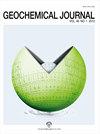Characteristics in trace elements compositions of tephras (B-Tm and To-a) for identification tools
IF 1.6
4区 地球科学
Q3 GEOCHEMISTRY & GEOPHYSICS
引用次数: 6
Abstract
Copyright © 2021 by The Geochemical Society of Japan. lacustrine and marine sediments can be preserved well when undisturbed by postdeposition erosion. Multiple dating studies using tephrochronology have been performed on lacustrine and marine sediments (Hopkins et al., 2015; Matsu’ura and Komatsubara, 2017; Sirocko et al., 2013). In order to establish the tephra layer as a robust chronological tool, it is essential to characterize each tephra using multiple approaches, such as morphology, mineralogy and geochemistry. The absolute date of the Millennium Eruption (ME) of Changbaishan Volcano (also referred to as Mt. Paektu, Baekdusan or Tianchi), located at the border between China and North Korea (Fig. 1a), has been defined as AD 946 analyzed by dendrochronological approaches (Hakozaki et al., 2018; Oppenheimer et al., 2017). This date is based on 14C contents in tree rings collected at the foot of Changbaishan Volcano by matching the observed 14C variations against the AD 774–775 14C spike (Miyake Characteristics in trace elements compositions of tephras (B-Tm and To-a) for identification tools用于鉴定工具的麻黄微量元素组成特征(B-Tm和To-a)
日本地球化学学会版权所有©2021。湖泊和海洋沉积物如果不受沉积后侵蚀的干扰,可以很好地保存下来。利用地表年代学对湖泊和海洋沉积物进行了多次测年研究(Hopkins et al., 2015;Matsu 'ura and Komatsubara, 2017;Sirocko et al., 2013)。为了将麻风层建立为可靠的年代工具,必须使用多种方法(如形态学,矿物学和地球化学)表征每个麻风层。位于中朝边境的长白山火山(也被称为白头山、白头山或天池)千年喷发(ME)的绝对日期(图1a)被定义为公元946年,通过树木年代学方法进行了分析(Hakozaki et al., 2018;Oppenheimer et al., 2017)。根据在长白山火山脚下采集的树木年轮中14C的含量,将观测到的14C变化与公元774-775年的14C峰值(tephras微量元素组成(B-Tm和To-a)的Miyake特征进行比对,作为鉴定工具
本文章由计算机程序翻译,如有差异,请以英文原文为准。
求助全文
约1分钟内获得全文
求助全文
来源期刊

Geochemical Journal
地学-地球化学与地球物理
CiteScore
1.70
自引率
12.50%
发文量
11
审稿时长
6 months
期刊介绍:
Geochemical Journal is an international journal devoted to original research papers in geochemistry and cosmochemistry. It is the primary journal of the Geochemical Society of Japan. Areas of research are as follows:
Cosmochemistry; Mineral and Rock Chemistry; Volcanology and Hydrothermal Chemistry; Isotope Geochemistry and Geochronology; Atmospheric Chemistry; Hydro- and Marine Chemistry; Organic Geochemistry; Environmental Chemistry.
 求助内容:
求助内容: 应助结果提醒方式:
应助结果提醒方式:


